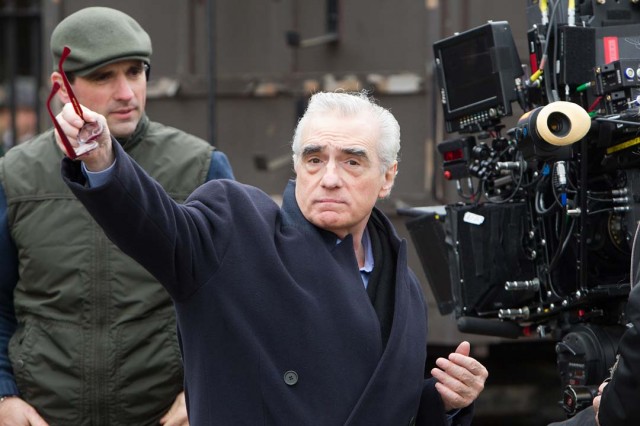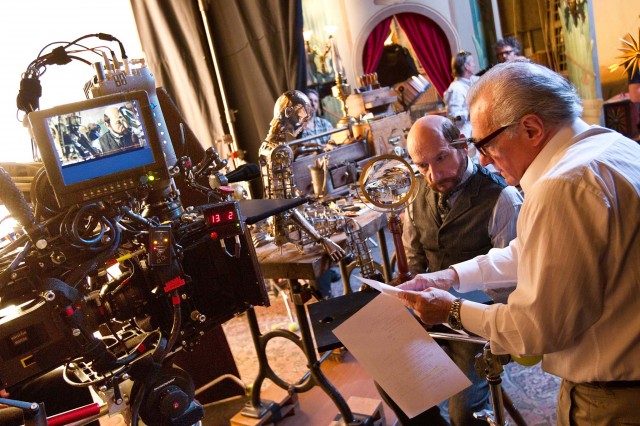
Director/Producer Martin Scorsese (center) on HUGO, from Paramount Pictures and GK Films. Photo: Jaap Buitendijk
A line of moviegoers stretched around the block outside the Regal Cinemas in downtown Los Angeles at 1 pm on Saturday, November 5. Hundreds of people from the filmmaking societies and guilds were waiting to enter an advance screening of Martin Scorsese’s newest film Hugo. Not only has this film been much anticipated for being Scorsese’s first using 3D, but a moderated conversation with the filmmaker and his team was to follow.
Hugo is based on Brian Selznick’s historical novel, The Invention of Hugo Cabret, and centers on a young orphan (Asa Butterfield) who lives clandestinely in the walls of a Paris train station in the late 1920s. The son of a deceased watchmaker, Hugo tends the station’s clocks while working to repair an automaton, a fully mechanical robot which is his last remaining link to his father. He is caught stealing parts from the toy shop in the station by the gruff, old shop owner (Ben Kingsley) and befriends the man’s goddaughter Isabelle (Chloe Moretz). Together they go on an adventure to get the automaton working again and unravel the machine’s mysterious connection to Isabelle’s godfather.
The story is a delightful tale of excitement and adventure as Hugo and Isabelle discover clues and learn more about each other’s very different worlds. The film, like the book, will be a hit with younger audiences.
But there is another great story in this film, especially but not exclusively for those fond of cinema history, the life and work of French filmmaker Georges Méliès. Between 1896 and 1914 Méliès directed 531 film and is credited with pioneering many special effects including: the stop trick, multiple exposures, time-lapse photography, dissolves, and adding color to film by hand. Had it been available in his time, there’s no doubt Méliès would be pushing the boundaries of 3D.
As mentioned, Hugo is a 3D film. It was shot in 3D using Arri Alexa cameras with Cooke 5/i lenses on Cameron/Pace mirror rigs. In this viewer’s opinion, the 3D was wonderful to watch. The intricate and layered sets were certainly built with the dimensionality of 3D in mind. Using simple depth, many of the overview scenes of the entire train station or of the city of Paris looked beautiful. The viewer is also presented with a number of interesting shots that extend out of the screen plane. The giant pendulum in the large clock tower comes immediately to mind.
Although the film will still be excellent in 2D, I would go see it again in 3D. In particular the scenes in Méliès’ workshop are notable for the staggered sets and props, which will resonate with anyone who has ever been backstage during a theatrical production. Considering that this was their first foray into 3D, I would say that the filmmakers did a superb job. Their use of 3D works well with the narrative and was clearly anticipated while filming.
Once the film ended to great applause, Q&A moderator and writer/director Paul Thomas Anderson was joined by Scorsese and his team: Robert Richardson, ASC, Cinematographer; Dante Ferretti, Production Designer; Thelma Schoonmaker, Editor; Robert Legato, VFX Supervisor; and Howard Shore, Composer.
Creating the film
“It was a lot of fun,” said Scorsese, “and yes, it was a headache, but a really enjoyable headache. It was a discovery with each shot, every facet of it was a rethinking of about how to make pictures. Obviously the element of 3D, but also the recreation of a boy’s memory of where he was in the past, and trying to create a sense of a heightened impression of Paris in 1929/1930. It was arduous but a great deal of fun.
“I have a young daughter. Being with her most of the time I have begun to see things differently and perceive life and the world around in a child’s view, the imagination of a child, the creativity of a child, but also a child’s thoughts and storytelling. So it just seemed to me to be a very happy coincidence with this story.”
Regarding the look of the film, Scorsese credited Dante Ferretti with knowing how he wanted the film to look. He wanted it to be a heightened version of Paris in this era, but without spilling over into fantasy. To this point Ferretti joked that Scorsese had helped by making him watch many, many, many period movies just to point out a shot that he liked in each one.
Georges Méliès
“(Shooting the Georges Méliès scenes) was a great deal of enjoyment,” said Scorsese, “but it started way in the beginning and took almost a year to filter down and decide which films, which images, which costumes, which trick effect, what elements to show what he did and how to show what he did in three or four minutes.”
The section in question was filmed in a replica of the studio that Méliès had built when he started making movies. The ceiling and walls were composed entirely of glass. Levered glass panels on the roof were covered in muslin and could swing to adjust the amount and location of light. Ferretti reconstructed the studio to exact dimensions on the back lot of Shepperton Studios in the UK and all the footage showing Méliès making his films was shot in this studio.
“It was shot entirely with natural light,” said Robert Richardson. “We just utilized the muslins up top to soften and allow soft light in.” Just the way Méliès had done it.
Richardson continued, “Marty had a very specific look that he wanted for the (Méliès sequence) and it was to go back to the autochrome, which is a very special feel that you get in those recreations. It’s a remarkable but limited palette of color. It’s extremely vivid.” To this end an autochrome LUT was created for the Arri Alexa cameras. After a shot they would play back the material to on-set 3D monitors with the LUT applied but without any color correction.
Music
When asked about the music in the film, Howard Shore described the 1920s as a “fantastically rich period. When you think of silent films, they really weren’t silent. There’s always music.”
The score used only two recorded songs, both from the 1937 French war film Grand Illusion directed by Jean Renoir, “Si tu veux marguerite” and “Frou-frou.” For the rest of the score, Shore evoked the style of the café from the period and incorporated a number of period instruments including: the ondes Martenot (a French theremin), the musette (a French accordion), and the tack piano.
3D
“The use of 3D is exciting but at the same time it demands a certain respect,” said Scorsese.
Richardson added, “We hadn’t shot 3D (before) so it was a learning process for us shot-by-shot.”
Scorsese again, “We were back to square one, but that was the excitement of it.” He seemed to have genuinely enjoyed working in 3D. “It was extraordinary because you would look at a shot and say ‘What can we do here? What can we do to use the depth as a narrative?’ That was the idea.
“The first time images started to move people immediately wanted color, sound, a big screen, and depth. And that’s just what we’re doing now.
“For me it’s just another element for telling a story…Why not use it? If everything moves along and there’s no major catastrophes were basically headed toward holograms. Why can’t you have Hamlet come out into the audience and do ‘To be or not to be?’ They do it in theatre. The actor walks right out into the center. Why can’t you have it in a movie theatre or at home? You have to think that way. Don’t let economics or fashion inhibit you if you’re being creative.”

Ben Kingsley (center right, as Georges Méliès) with Martin Scorsese on HUGO, from Paramount Pictures and GK Films. Photo: Jaap Buitendijk
Editor’s technical notes: “Hugo” was the first 3D feature film to use Arri Alexas, with Pace 3D rigs, and the first to use all three sets of Cooke lenses: 5/i, S4/i, and Panchro/i. The little box with 3 LED lights on it, above the BACKUP “A” PADDLE label, is a Cooke /i illuminated focus scale dimmer.
Gregor Tavenner, 1st Camera Assistant on the production said, “The Cooke 5/i illuminated focus scales were low on my list when I first saw them. But guess what. This was a perfect application for it. Two lenses inside a dark and crowded 3D rig, no way a Maglite–or two Maglites–would get in.” Other gear in picture above: two Transvideo CineMonitorHD8 Monitors, Cinematography Electronics Cine Tape Measure, Preston Cinema Systems MDR, OConnor 120EX head.
Why two Monitors? Gregor explains, “I purchased an 8” Transvideo HD monitor and Pace then bought another. They were both mounted to the 3D rig. These monitors were
chosen for their superior image quality, still my favorite. We used two monitors for two reasons: QC check for focus puller so I can see BOTH cameras to check focus and image quality. Also, so many creative conversations and decisions happen right at camera, so why not a monitor on each side? I have done this on 2D as well and it just helps everybody.







